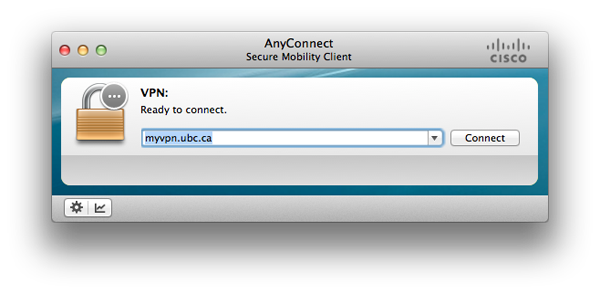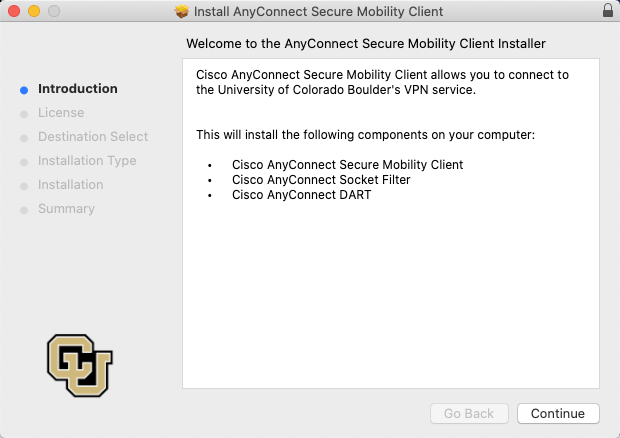VPN, CISCO AnyConnect, Installing Cisco AnyConnect VPN for Mac OS X This page contains links to download and installation instructions for VPN software for Mac OS X University of Illinois students, faculty, and staff can use these directions to set up their Mac OS X computers or devices to connect to the Virtual Private Network (VPN). The icon for the vpn client is in the menu bar in the upper right and in the dock at the bottom of the screen. To run the AnyConnect client in the future, look for the Cisco AnyConnect Secure Mobility Client icon in Launchpad or your Applications folder. IntelliShield has updated this alert to notify customers on the availability of software updates to address the Cisco AnyConnect Secure Mobility Client for Linux and Mac OS X privilege escalation vulnerability. The 4.6.02074 version of Cisco AnyConnect Secure Mobility Client for Mac is provided as a free download on our website. The most popular versions of Cisco AnyConnect Secure Mobility Client for Mac are 3.1 and 3.0.
MacOS provides native support for connecting to the IT Services Cisco-based VPN service. Please note that IT Services support the current and two previous versions of macOS only; for details of supported versions please refer to the Apple Mac Support page.
This document contains instructions on how to configure the native VPN client that comes with macOS. In order to use the VPN service you will also need to have the necessary Remote Access Services username and passwords - for details see the main IT Services VPN Service page.
Mac OS (Pre-Big Sur) Instructions. Downloading the VPN software. Download the Mac VPN installation package from the WebStore. Save the file at an easily findable location, such as your desktop. Installing the VPN software. Go to the location where you saved the VPN installation package. Double-click on the.dmg file. AnyConnect for Mac OS X, download best alternative solutions carefully chosen by our editors and user community.
- AnyConnect Secure Mobility Client v4.9.0195 – Windows, Mac, Linux. Published on 06 September 2020 By Administrator 41024 downloads. Download (zip, 69.64 MB) cisco-anyconnect-490195.zip. Complete Cisco AnyConnect Secure Mobility Client for Windows, Mac OS X 'Intel' and Linux (x86 & x64) platforms for Cisco IOS Routers & ASA Firewall Appliances.
- AnyConnect Headend Deployment Package (Linux 64-bit) Login and Service Contract Required. AnyConnect Pre-Deployment Package (Mac OS) Login and Service Contract Required.
Please make sure that you have read the introduction and general requirements, which apply to all VPN clients, before attempting to configure your computer or mobile device to connect to the VPN.
1. Requirements
There are a number of requirements necessary in order to use the VPN service on Apple Macintoshes; these are detailed below.
- Your computer must be running a supported version of macOS (see Apple Mac Support page for details).
- You computer must already have a connection to the Internet (e.g. via NTL, Compuserve, broadband, ADSL, etc., etc.)
- You must have a Remote Access Services account.
- You must be able to log on as an Administrator of your Mac.
2. Obtaining the prerequisite information for configuring the inbuilt VPN client
As part of the process of configuring the inbuilt VPN client you will need to supply some group configuration information. Members of Oxford University can download a file containing this information from the IT Services Self-Registration Software Registration and Downloads web page. Once on this page select VPN client from the list. On the next page that appears select VPN shared credentials. A window containing the information should now pop up on your desktop. Make a note of the IPSec secret as you will need this information later on (it will be referred to as the shared secret) and then close the window using the close window link.
You have now obtained the information that you need from the Self-registration web pages.
3. Configuring and using the inbuilt VPN client
To use the macOS inbuilt support for Cisco VPN you will first need to open [System Preferences], which you can do from the dock, the [Apple] menu or by finding it in the Applications folder.
From the [System Preferences] window click the Network icon to bring up the Network window.
Click the + at the bottom of the left hand pane to bring up a dialogue window to add a new network interface. Within the dialogue window make the follow changes:

- set the
Interfacedrop down menu toVPN - set the
VPN typedrop down menu toCisco IP Sec - change the
Service Namefield to something that is meaningful to you, egVPN (OUCS)
Finally, click the Create to add the new interface. This will return you to the Network window with the newly added interface ready to configure. To configure the interface make the following changes:
- set the
Server Addressfield tovpn.ox.ac.uk - set the
Account nameandPasswordfields to your remote access account name and password
Next click the Authentication Settings.. button to bring up another dialogue window which requires the following information:
- click the
Shared secretradio button and fill in the text field using the information that you obtained earlier - set the
Group Namefield tooxford

Click the OK button to return to the Network window. If you are likely to use the VPN client regularly you may want to include the status of the VPN connection in your menu bar. If you do want to do this you must tick the check box labelled Show VPN status in menu bar.
Finally, click the Apply button to complete the configuration for this new VPN interface. The new interface should now appear in the left hand pane indicated by a locked padlock icon. Note that the status of the interface will show as Not connected.
To make a connection to the VPN service simply click the Connect found on the Network window. (This can be found underneath the Authentication Settings.. button.) Once the connection has been established the Network window will show that the status of the VPN interface has changed to Connected and it will display the connect time and the IP address.
4. Connecting to the IT Services VPN service using the inbuilt VPN client
Once you have configured a network interface on your Mac to connect to the IT Services VPN service you can make a VPN connection whenever you need to. To connect via the inbuilt client:
- Open
[System Preferences] - Click the
Networkicon to switch to the Network window - Select the VPN connection you configured previously (in this example called
VPN (OUCS)) in the left hand pane - Click the
Connectbutton (found underneath theAuthentication Settings..button)
Do remember to disconnect from the VPN service once you no longer need it by clicking the Disconnect button within the Network window.
Alternatively, if you chose to include the status of the VPN connection in your menu bar by ticking the box labelled Show VPN status in menu bar during the configuration process you can connect and disconnect using the VPN icon in the top menu bar. Look for the VPN icon in the top menu bar and click the icon to bring up the drop down menu.
Simply choose the [Connect] option from this menu to make a VPN connection. You can also use this menu to disconnect your session once you no longer need it.
5. Further Information
For information on firewalls and IP address allocations refer to the IT Services VPN Service technical details page.
Anyconnect Client Download For Mac
If you have problems with the inbuilt client you may be advised to use the Cisco AnyConnect Client. Instructions are available from the Configuring the AnyConnect Client on Mac OS X Systems page.
What if I am having problems with the automatic installation?
1. Open a web browser and go to https://anyc.vpn.gatech.edu. This will redirect you to a login page similar to this one:
2. Enter your username and password (same as you use for Buzzport, Techworks, etc)
Supervpn Free Vpn Client Free Download
3. Your next screen will be our welcome banner. Click 'Continue'
Cisco Anyconnect Mac Os X

4. At this point one of two things will happen. The Java install will work, or it will fail. If the java install fails, click here for instructions on how to continue installing manually.
5. If the java install continues, you may be prompted to allow the vpn access to your computer. Click 'Allow' to continue the installation.
Cisco Anyconnect Client For Mac
6. Enter your username and password for the Mac itself and click 'OK'
7. The following screen will appear as the client is installed.
8. When the installation is complete, a screen similar to this will appear.
Download Anyconnect Client Mac
9. You may close your browser. The icon for the vpn client is in the menu bar in the upper right and in the dock at the bottom of the screen.
10. To run the AnyConnect client in the future, look for the Cisco AnyConnect Secure Mobility Client icon in Launchpad or your Applications folder: Vmware client for mac quit unexpectedly.
11. Once you open the AnyConnect Secure Mobility Client, login with your username and password:

Cisco Anyconnect Download For Mac Catalina
12. Once you connect, the AnyConnect window will minimize. To restore the window, you can click the icon at the top of the screen and 'Show AnyConnect Window'
Cisco Vpn Client Free Download
13. To view current connection information, you can select 'Show Statistics Window' or click on the graph icon on the AnyConnect window.
Cisco Anyconnect Vpn Client Free Download
14. To disconnect the client, click on 'Disconnect'
The Cisco AnyConnect VPN client is used to make a secure, direct connection to specific SolutionHealth resources. The primary use of the Cisco AnyConnect VPN client is to allow authorized users to connect directly to desktops or shared servers using 'Remote Desktop Connection'. PREREQUISITE: - You must have the Cisco AnyConnect VPN client installed on your Mac OSX device (see below). - You must have Microsoft Remote Desktop installed on your Mac OSX device (can be found in the Apple App Store). - You must be enrolled in the Duo MultiFactor Authentication System and have your enrolled smartphone available. - Refer to the main Remote Access Help Documents for additional information. Instructions: 1. On your Mac OSX device, download the Cisco AnyConnect VPN client from the following location: CISCO ANCONNECT VPN CLIENT - MAC OSX 2. Once the download is complete, locate and run the AnyConnect 'DMG' file. 3. Run the AnyConnect.pkg application. 4. Click 'Continue' to begin the installation process. Be sure to accept the license terms. 5. IMPORTANT - In the 'Installation Type' screen, only select the 'VPN' option. Leave all other options un-checked. 6. Allow the installation to complete and click 'Close'. When prompted, choose 'Move to Trash' to clean up the installation file. 7. Once the installation is complete, locate and launch the 'Cisco AnyConnect Secure Mobility Client' in your Mac OSX Finder. 8. Enter 'vpn.solutionhealth.org' in the connection window and click 'Connect'. 9. Select the desired group, enter your network login and password, then click 'Ok' Group:
Password: EHS or SNH Network Password IMPORTANT - If you receive a certificate error, you may safely ignore this error. 10. When prompted, approve the login request using the Duo Multi-Factor authentication app on your smartphone. 11. You should now be connected to the SolutionHealth Cisco AnyConnect VPN. 12. To connect to your work desktop or to server resources, you will need the 'fully qualified name' of your PC or desired server. Example:
13. Locate and launch 'Microsoft Remote Desktop' using your Mac OSX finder. (If you do not have this application, you may need to download it from the Apple App Store). 14. Click 'Add PC' 15. Enter the 'fully qualified name' of your PC, or to connect the the SNHMC 'IVE' enter 'tscluster.snhmc.org'. You may also assing a Friendly name for this connection. It will be saved next time you run Microsoft Remote Desktop. 16. When prompted, enter your network login and password and click Continue. - If you normally log into a Nashua/SNH computer or to use the SNHMC 'IVE', use 'NTMCusername' - If you normally log into a Manchester/EHS computer, use 'ELLIOTusername' IMPORTANT - if you receive a certificate error, you may safely ignore this error and click 'Continue'. 17. When you are done, you may disconnect from the remote PC or server and disconnect from the Cisco AnyConnect VPN. 18. Procedure complete. Great Job! |